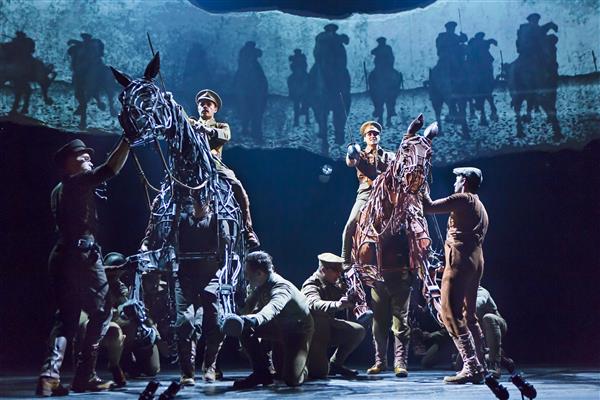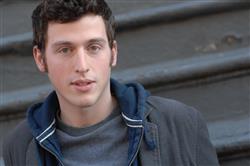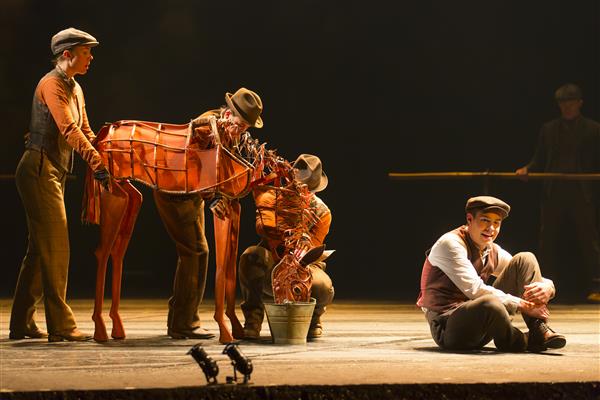
Adapted from the best-selling children’s book, War Horse is a promising piece of theater that may be one of the most unique shows of TPAC’s line-up.
Following the perspective of Joey, a horse who has been recruited for the battlefield effort of World War I, audiences are offered a universal understanding of emotion by showing that the compassion of animals and beast-like nature of war blurs the boundaries between animal and man.
Jon Riddleberger, head puppeteer for the War Horse lead, Joey, was able to chat with the Pulse about his involvement before its opening night on June 3.

Murfreesboro Pulse: So you’re operating the head of the puppet Joey, the main character in War Horse. This is a very interesting looking puppet. Can you describe the construction of the puppet?
Jon Riddleberger: Yeah, so the horse puppets in the show are a little bit larger-than-life puppets. They’re made of cane and aluminum and leather, and the mane and tail is made up of a material called Tyvek, which is basically what FedEx envelopes are made of. And the horses were handcrafted in South Africa, under the guidance of the Handspring Puppet Company. It’s a company who initially created the horses and worked the show with the [Royal] National Theatre when it was first put up in England. And the horses went through a lot of different tests and development phases, and so the horses took a long time to make and develop to be as effective as possible.
So the horses were made by hand? How long do you think they took to make?
The workshop that they had opened could make a full set of puppets for the show. That includes Joey and Topthorn, who are the two main horse characters, as well as some other horses in the show that aren’t as full. There’s also some human puppets and some crow puppets. I think that it took them about a year to make all of those puppets.
You said that there are human puppets in the show as well? How many of the players in the show are non-puppets?
We have an ensemble of 43 people. It’s a mixture of puppets and human actors. Really in terms of the main characters of the show, they’re all human aside from the two main horses. The other puppets that are used through the show . . . there are bird puppets kinda throughout different scenes outside. There are human puppets that are used for different scenes of cavalry charge, with six horses charging at the Germans, and we use a combination of people and puppets to do that. The show is more “puppety” in the war in a lot of ways. The stage is very bare. We have very few set pieces and the set pieces we do have have to move in and out very quickly around the stage. So everything is sort of representational, and the show does an incredible job at creating epic moments using very little on stage. Part of what helps make that happen is the use of puppets; is the use of human puppets that help us to allow pictures on the stage and this kind of stuff. So in terms of the main characters, it’s mostly human and a couple of horses.
When moving Joey, are you looking to convey the same level of emotion that you would have playing any other character, or do you feel limited in scope because you’re portraying something that isn’t directly human? Or is that even possible, considering you are operating Joey the puppet with two other performers?
Yeah, that’s the goal. That’s the job. I think of what I do as acting. Puppet-ing the horse. A lot of the puppeteers in the show are trained actors. The difference is, like you said, I’m working with two other people. So we have to kind of develop a “group mind,” and that’s an imperfect process . . . which is part of what makes it great. I’m able to work with two other people who are going to have different instincts than me, and are going to make different decisions that I make. And that does nothing but give me opportunities to find something new. And when I do something that is different from what they would do it gives them an opportunity to do something new. So together the team kind of creates a new character. That is a combination of the three of us. But then on top of that, what matters is the puppet. So my personal feelings as a single puppeteer in the horse don’t matter as much as what the puppet is experiencing. So as an actor, [I’m] sort of projecting the emotional life onto the puppet as opposed to experiencing it fully myself. It’s an interesting process that’s hard to describe.

To sum that process up, you’re collaborating with two other people to not necessarily show the full range of emotion yourself, but to help part of that emotion come to life, as you’ve got two other performers “filling in the blanks” in the performance.
We each have different jobs within that. So I’m the head puppeteer, meaning that I operate the head of the horse and control the ears. My job is really to focus on “What does Joey see, what is he hearing, what is he thinking?” Really embracing that part of the horse. Then the heart puppeteer, who is in the middle, is controlling the legs and the breath. So that’s a very . . . in terms of the emotional center of the horse, that puppeteer is giving that breath, which is so informative about what state of tension the horse is in. What feeling the horse is having. And then the hind puppeteer in the back controls the back two legs and the tail, and that puppeteer is in charge of really the strength of the horse. The push of the horse, and the big, muscular motions. And you know, there’s lot of overlap in our jobs. So the hind puppeteer needs to also be thinking about what Joey’s seeing, or else I’m going to be doing something completely different from my hind puppeteer. But we each have a place within the full picture that we’re filling out and that we’re representing.
So in a way, as you’re controlling different areas of the horse, you’re controlling different characteristics both physically and emotionally?
And that’s the sort of game we play onstage every night, and we’re given that opportunity to really do something impossible, which is “think as one person.” And kind of like what I said before . . . what the audience is watching, is full of mistakes. But when not treated like mistakes or negative things, they become opportunities. And it’s what gives that kind of spontaneity to the horse that runs in line with an actual horse—an actual animal that is unpredictable, who reacts in different ways. Sometimes horses will react because they hear something. Sometimes they’ll react because they sense something. So they’re different ways in terms of reacting intellectually to reacting physically. We’re kind of playing this game where we’re passing the ball between each other and collaborating. It’s really a big improv game.
How did you and the other actors study for the portrayal of Joey?
Well, it started with just two weeks of puppet rehearsals. With all the puppeteers, we have a total of 13 puppeteers who puppet the big horses in the show and then three puppeteers who puppet Joey when Joey’s a foal. So it was the sixteen of us for two weeks studying horses. We spent it at the stables, we watched videos, we even watched things like the dissection of a race horse, stuff like that. We read books. We also just did various puppet exercises. So we worked with puppets that weren’t the horses, and those two weeks were really spent focusing on how to be a horse, in the beginning of that process, as well as how to be a team and a puppeteer. So we had a solid two weeks just working on that stuff, and then the full cast joined us. That’s when we started working on the script. Part of the process was learning the basics: How do we walk? How do we do this and that? So that when our director says, “Hey, can Joey walk across the stage at this point?” that we can do that. It’s an ongoing process, so I’m a different puppeteer two weeks ago than I was a year ago. We’re kind of always evolving with these puppets. There’s always something new to learn, and there’s always something new to find out. Whenever I see a horse on the street, it’s probably likely that some of that horse’s behavior is going to be in the show that night.
Really?
Yeah, and we’re given that freedom. There’s a lot of choreography, there’s a lot of watching obviously in the show. But we were told by our director that “We’re going to give you ‘Point A’ and we’re going to give you ‘Point B.’ You have to get there. Just hit those points. But that in between, how you get there, is up to you and your team.” So we’re given a lot of freedom and we’re given, you know, each team, as there are four puppet teams. Each team who does Joey is a different horse, and it helps keep the show fresh.
In what way did you portrayal of Joey change your perception of animals? Do you find yourself becoming more critical of the way people treat animals.
I think so, yeah. I’ve always had a soft spot for animals. I’ve always been a big dog person. I’ve actually always been tentative around horses. I don’t want to do the wrong thing. And I think that learning more about horses makes me want to not do the wrong thing even more. I don’t want to spook them. I don’t want to do something that makes them uncomfortable. Learning about how a horse sees the world gives me a lot of respect for them as animals. A lot of the kind of training and therapy that goes on with horses is all about passive leadership. Horses have this ability to mirror their emotional life and the circumstances that are going on around them. There’s a lot of therapy done where the patients work with horses, and the horse will actually start to take on the emotional life of the patient. Through the patient having to deal with the horse, they in turn are dealing with themselves. It’s really incredible stuff, and I think that fact that a horse is as strong as it is, and is still patient enough to work with humans and still work with us is really a testament to their generosity and their gentleness. So I think it’s given me that sort of respect and understanding of how incredible the fact that we have relationships with these animals is.
Fascinating. And for the viewers of the show, what do you hope that someone who watches War Horse walks away with, in terms of theme?
So, Michael Morpurgo is the author who wrote the original book. He calls this story “an anthem for peace.” And I think I agree with that; we as an audience are able to watch the conflict through the eyes of a neutral party, which is the horse. I think that it really enlightens the point with this. Of war, and the kind of neutral playing field that people were on. Whether you were German, or whether you were English or French, there are bad people and good people on both sides. I think that kind of voice is really big and effective. I think that one of the greatest things about this show is that the use of stagecraft and puppetry lets the audience imagine the story and engage with the story. They become our fourth puppeteer, really. We can do all we want on stage, but it’s the audience choosing to believe in us, choosing to go in that journey that fills out the last part of the equation. And because audiences choose to partake in that, I think they feel so much closer to the story. I think that is the best thing someone can leave with. Having had an experience, having used their imagination, and having some reflection about conflict and peace.
~~~
War Horse will be at TPAC’S Andrew Jackson Hall in Nashville June 3-8. For tickets and information about the show, visit TPAC’s website for the show.













